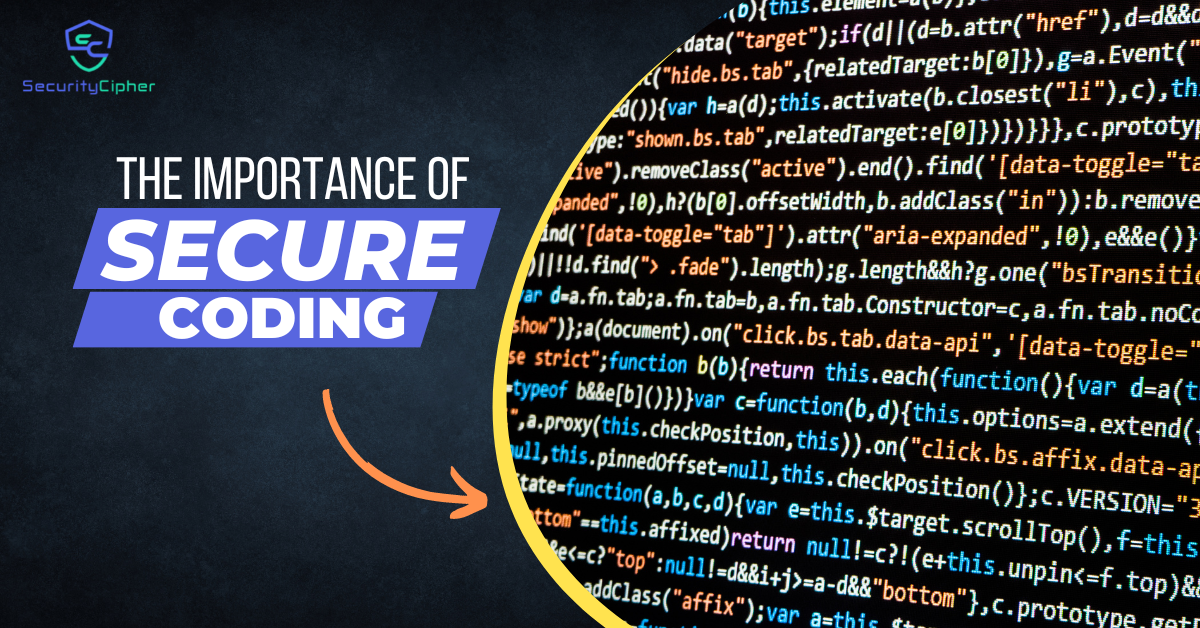The growing number of security breaches in recent years is a clear indication that we must prioritize code security. By writing better and more secure source code, developers can prevent a wide range of potential exploits and attacks. Investing in the security of your code is crucial to protect both your users and your business. By adopting best practices and staying up-to-date on the latest security techniques, you can help ensure that your apps are as secure as possible.
These attacks have exposed the sensitive information of millions of individuals, putting their financial and personal data at risk. By ensuring the integrity of our code, we can protect against these threats and safeguard our programs from potential attacks.
Introduction to Secure Coding
Secure coding is an essential part of software development that focuses on incorporating security measures into the design and implementation of a code. It involves using various techniques and practices to prevent security vulnerabilities and ensure that the code is resistant to common threats such as hacking and data breaches. Secure coding is crucial for protecting the sensitive information and data of users, as well as the integrity and reliability of the software.
By adopting secure coding practices, developers can safeguard against security risks and vulnerabilities that may arise during the development process. These practices include following coding standards and guidelines, conducting regular code reviews, and implementing robust testing and validation techniques.
Top Secure coding practices
Developers play a crucial role in protecting sensitive information and systems from potential threats. To ensure the security and integrity of their code, it is essential for developers to understand and implement secure coding practices. Some key practices that every developer should know include:
Input Validation
Input validation involves verifying and validating user-supplied input to ensure that it is valid and conforms to the specified format. This helps to prevent malicious attacks and vulnerabilities in the code. By implementing input validation, developers can ensure that the input is within the expected range, is the correct data type, and does not contain any illegal characters or special characters that may be used for injection attacks. This process helps to maintain the integrity and security of the code and protect it from potential threats.
In the below example code, we first validate the input using the validateInput() function. This function checks the type of the input, its length, and its content to ensure that it is valid. If the input is not valid, an error is thrown and the processInput() function will not continue. This helps to prevent attacks that try to exploit weak input validation vulnerabilities by providing invalid or malicious input to the application.

Error Handling
Error handling involves identifying and addressing potential errors or exceptions that may arise during the execution of a program. Proper error handling ensures that the code remains stable and reliable, preventing potential security vulnerabilities. In particular, secure code should implement robust error handling mechanisms that capture and log error messages, allowing developers to quickly identify and resolve any issues. This can help prevent the exploitation of vulnerabilities by attackers, protecting the system and its users from potential harm. By implementing effective error-handling strategies, developers can ensure that their code is secure and resilient, providing a high level of protection for the system.
In the below example code, the method “processData” takes in a String of data and attempts to parse and process it. If an “InvalidDataException” is caught, it logs the error and returns a default value. If any other exception is caught, it also logs the error and returns a default value. This ensures that any errors that occur during the processing of the data are properly handled and do not cause the program to crash.
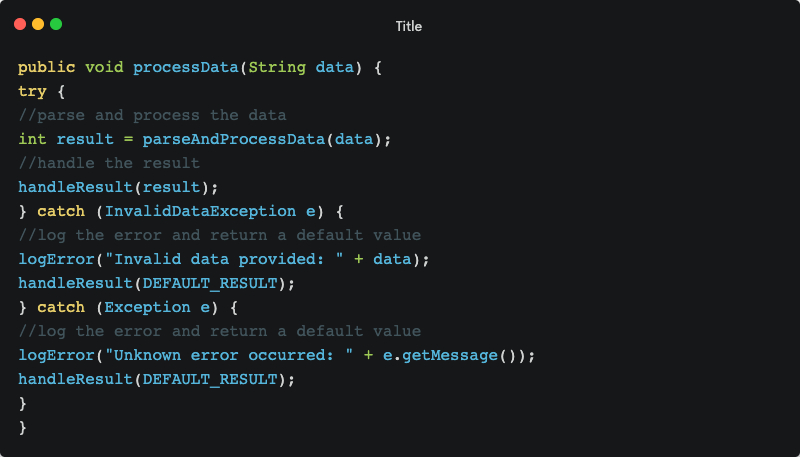
Improper Logging
It is crucial that sensitive information, such as personal financial data or confidential business information, is not logged in server or application logs. This information is often vulnerable to cyber attacks, and logging it could lead to potential data breaches and security issues. In order to prevent this, organizations should implement strict policies and protocols to ensure that sensitive information is not logged in server or application logs. Additionally, regular security audits should be conducted to ensure that these policies are being followed and to identify any potential vulnerabilities.
In the below example code, we first import the necessary logging module and set up the logger with a level of logging.INFO. We then define a custom log filter that will exclude log records that contain credit card numbers. Next, we add the custom log filter to the logger and log an example credit card transaction, where the credit card number is not included in the log message. The log message will only be logged if it does not contain a credit card number.

Hardcoded Credentials
Using hardcoded credentials in your code is a major security flaw that can leave your application vulnerable to attacks. This practice involves storing sensitive information, such as passwords and usernames, directly in the source code, which can easily be accessed by anyone with access to the code. It is recommended to avoid using hardcoded credentials and instead implement a secure way to store and manage sensitive information, such as using encrypted password storage and a secure authentication mechanism.
In the below example code, We are using Azure Key Vault library to fetch a secret from Azure Key Vault. It creates an instance of the SecretClient class and uses the get_secret() method to retrieve the secret with the specified name. The value of the secret is then extracted from the KeyVaultSecret object and converted to a byte array. Finally, the SHA256 hash of the byte array is calculated using the “hashlib” library. This hash value could then be used for various purposes, such as encrypting or verifying data.

Access Control
Access control involves restricting access to sensitive information and systems to only authorized individuals. This can include implementing strong and unique passwords, using authentication methods such as two-factor authentication, and regularly updating passwords to prevent hackers from accessing systems using outdated credentials. Access control also involves limiting access to sensitive data and systems to only those users who have demonstrated authorization and need access to the information. By implementing proper access control, developers can help ensure the security and integrity of their code and protect sensitive information from potential threats.
In the below example code, We are checking whether a user has the proper role to access a specific path, in this case “/api”. The code defines a list of allowed roles, in this case “admin” and “user”, and checks whether the user’s role is included in this list. If the user’s role is included, then access is granted and a message is printed to the console. If the user’s role is not included in the list of allowed roles, then access is denied and a message is printed to the console. This ensures that only users with the proper role can access the specified path.
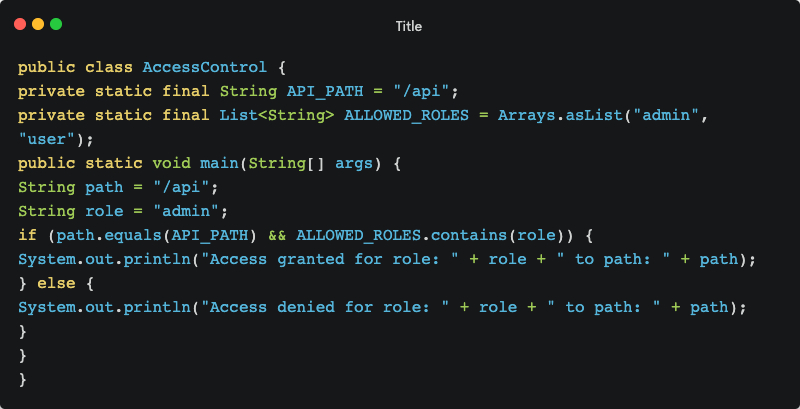
Encrypt Sensitive data
Encrypting sensitive data is a critical step in protecting against unauthorized access and potential data breaches. This can include user passwords, financial information, and any other sensitive data that needs to be protected. Encrypting data helps prevent man-in-the-middle attacks where an attacker intercepts and attempts to read sensitive information. By implementing encryption, developers can help ensure the security and integrity of their code and protect sensitive data from potential threats. This is an essential practice for maintaining the trust of users and clients and preventing potential data breaches.
In the below example code, we are using using the “hashlib” module in Python to encrypt the user’s password using the “sha256” hash algorithm. The encrypted password is then stored in a MySQL database. The user is prompted for their password and the input is encoded before being passed to the “sha256” function to generate the encrypted password. A MySQL connection is established and a query is executed to insert the username and encrypted password into the users table in the database. The changes are committed to the database and the connection is closed.

Component with known vulnerabilities
When writing code, it is essential to avoid using components with known vulnerabilities. This can include libraries, frameworks, or any other third-party code that has been identified as having security vulnerabilities. Using components with known vulnerabilities can expose systems to potential attacks and put sensitive information at risk. To prevent this, developers should regularly check for known vulnerabilities and avoid using components that have been identified as having security issues. Additionally, developers should update components regularly to ensure they are using the latest and most secure versions.
In the below example code, it is importing the jQuery library and updating it to the latest version by using the $.getScript() function to load the latest version from the jQuery website. This ensures that the jQuery library being used is up to date and has the latest features and fixes.

Some Opensource Tools for Detecting Vulnerabilities in Code and Libraries
There are various open-source tools available for detecting vulnerabilities in code and libraries. These tools can help developers identify potential security issues in their code and provide guidance on how to fix them. Some popular open-source tools for detecting vulnerabilities include:
SpotBugs
SpotBugs is a static analysis tool that helps developers identify potential security vulnerabilities in their code. It analyzes code for potential bugs and errors that can expose systems to attacks and provide developers with guidance on how to fix these issues. SpotBugs uses dataflow analysis to identify potential vulnerabilities and provides developers with clear and actionable recommendations to help them fix the issues. It is easy to integrate with existing development environments and is available as a standalone tool or as a plugin for popular integrated development environments such as Eclipse and IntelliJ. Overall, SpotBugs is a valuable tool for developers looking to improve the security of their code.
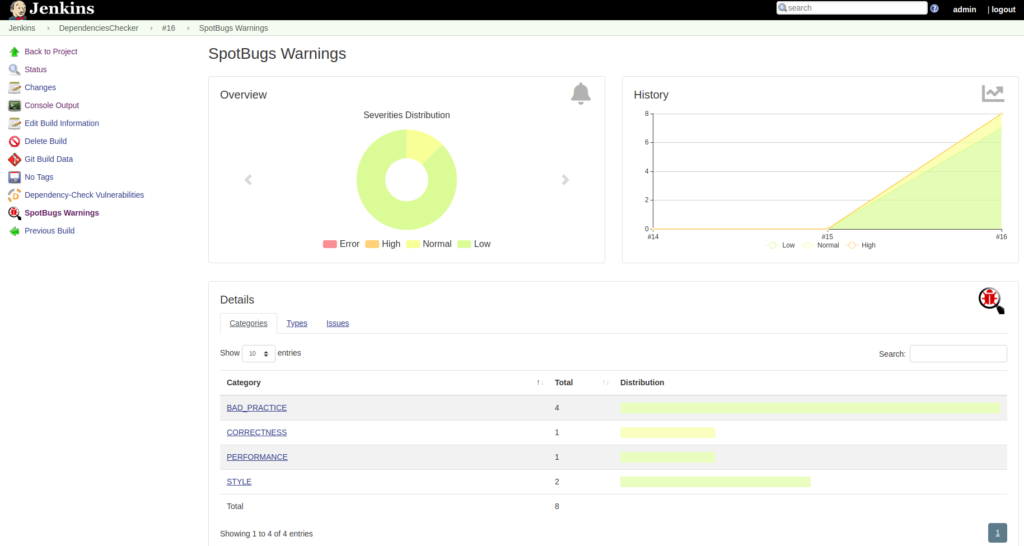
Semgrep
Semgrep is a powerful tool for identifying security vulnerabilities and code issues in source code. It uses advanced pattern matching and code analysis techniques to quickly and accurately scan code for potential vulnerabilities and other issues. With Semgrep, developers can easily identify and fix security vulnerabilities and other code issues before they become a problem. The tool is easy to use and can be integrated into existing development processes, making it an essential tool for any developer looking to improve the security and quality of their code. Additionally, Semgrep offers a variety of customization options, allowing developers to tailor the tool to their specific needs and preferences. Overall, Semgrep is a valuable tool for enhancing the security and quality of code.
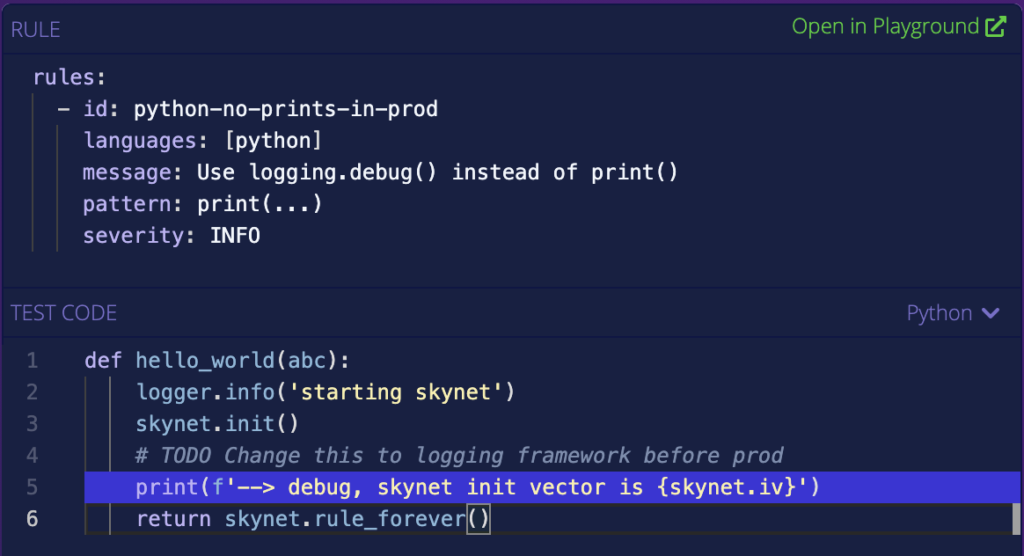
Soanrqube Community Edition
SonarQube is a popular open-source tool for static code analysis. It helps developers identify and fix bugs, vulnerabilities, and code smells in their code. The community version of SonarQube is free to use and provides a range of features for analyzing code quality, including support for over 20 programming languages. It also integrates with popular development tools such as Jenkins and Azure DevOps, making it easy to incorporate into the development workflow. Overall, the community version of SonarQube is a valuable tool for developers looking to improve the quality and security of their code.
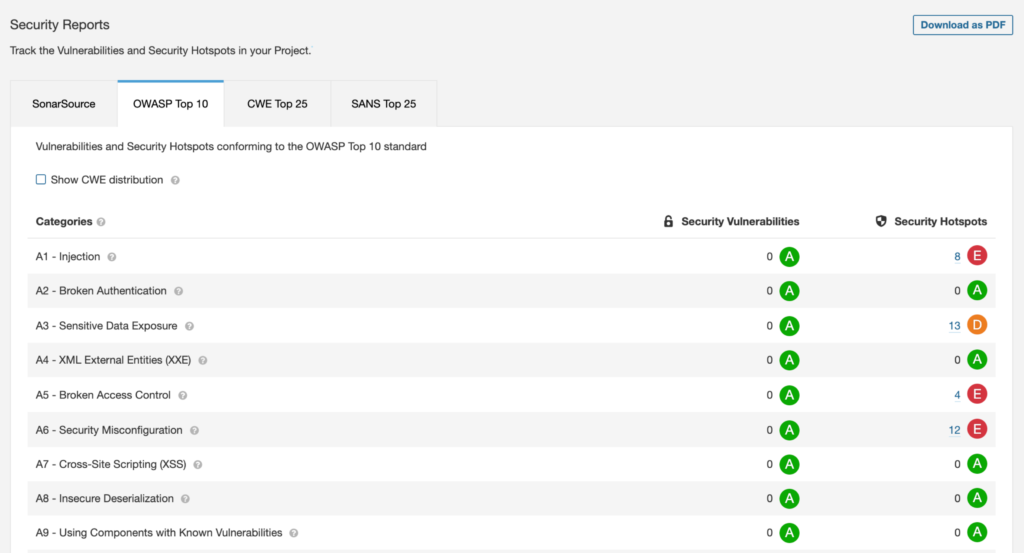
OWASP Dependency check
OWASP Dependency Checker is a tool that helps developers identify potential vulnerabilities in third-party components such as libraries, frameworks, and other code dependencies. This tool scans dependencies for known vulnerabilities and provides a report on any potential issues. By using OWASP Dependency Checker, developers can ensure that their code is using the most secure versions of components and reduce the risk of potential attacks. Additionally, the tool can help developers stay up to date with the latest security patches and vulnerabilities, making it an essential tool for maintaining the security and integrity of code.
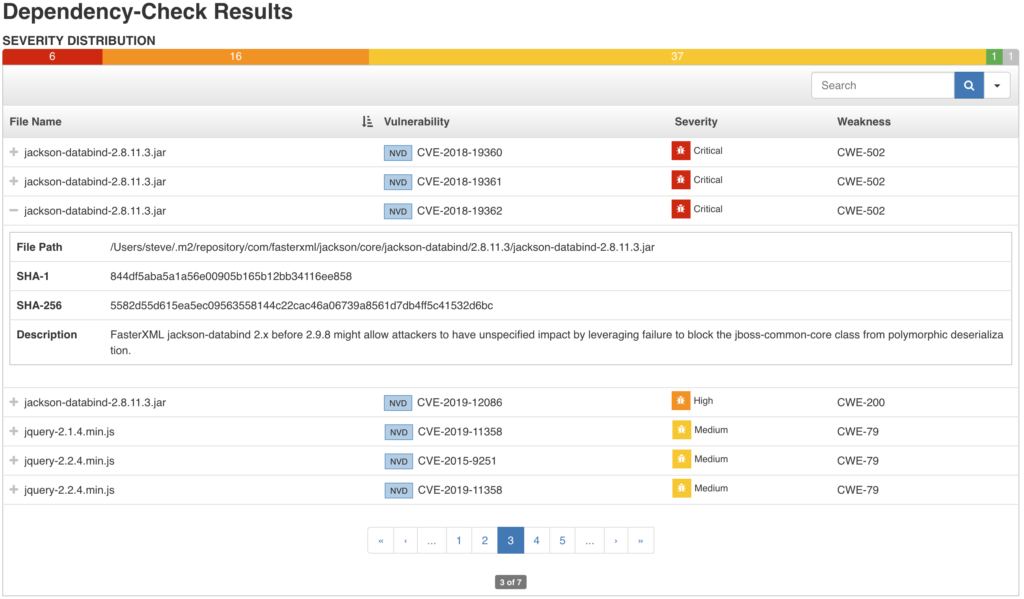
OWASP Secure Coding Practices
One of the best ways to improve the security of your code is to go through the OWASP Secure Coding Practices. This is a comprehensive set of guidelines and best practices for writing secure code. It covers a wide range of topics, from input validation and authentication to encryption and software updates. By following these guidelines, developers can help identify potential vulnerabilities and provide guidance on how to mitigate them. The OWASP Secure Coding Practices are a valuable resource for developers looking to improve the security of their code and protect sensitive information from potential threats.
For more information, please visit the website. : https://owasp.org/www-project-secure-coding-practices-quick-reference-guide/
Conclusion
In conclusion, secure coding is essential for protecting sensitive information and systems from potential threats. By following best practices such as input validation, using secure coding frameworks, encrypting sensitive data, implementing secure authentication methods, and keeping software up to date, developers can ensure the security and integrity of their code. Implementing these practices can also help prevent potential data breaches and maintain the trust of users and clients. Overall, the importance of secure coding cannot be overstated and should be a top priority for all developers.

